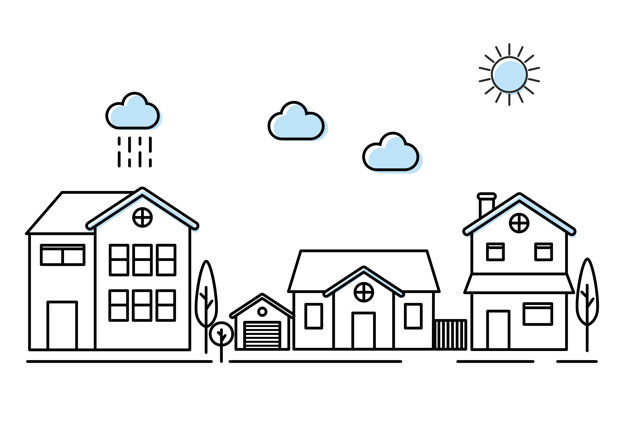Whether a one-story home is a better investment than a two-story house depends on personal taste to a great extent, as well as on the local real estate market and that old adage: location, location, location. Multi-level homes offer many benefits, but they also have a few inherent drawbacks…and so do one-story homes as well.
Compound Size
It works out to 3,200 square feet per lot when all properties on a city block have lot sizes of 40 feet wide by 80 feet deep. Some city codes might allocate a percentage of that .07-acre lot size to a structure erected upon it. The “footprint” of your home couldn’t exceed 1,280 square feet if the city code says that the building can’t occupy more than 40% of the lot.
So single-level homes in the neighbourhood would have maximum square footage of 1,280, while a multi-level house could be twice that size or 2,560 square feet. A one-story home is often priced more per square foot than a two-story for this reason.
You might find that a single-floor home takes up more of the lot than a multiple-level home, which wouldn’t be ideal if having a big yard is one of your priorities. Builders might make the foundation 900 square feet for a three-story property, which would actually increase the usable space in a 3,200-square-foot yard. A foundation of 900 square feet would use about 28% of the lot versus the 40% of the single-floor house.
People with families who want bigger yards would tend to gravitate toward a multi-level home and the larger square footage of 2,700 square feet.
Sound Effects
Some contractors say that joists should be spaced 12 inches apart on a second level to reduce squeaks and sounds from the floor. The older the home, the further apart the joists typically are. But, to be fair, the span of the joists is usually larger in an older house.
The sound from television might easily travel to the second floor if a bedroom is located directly over the family room. This would make it difficult for anyone trying to sleep in that bedroom while a night owl family member watches TV downstairs.
And you might just be tired of listening to sounds travelling through floors, walls, and ceilings if you’re a first-time homebuyer who’s been renting and listening to all that for years.
In Case of Emergency
Unfortunately, natural disasters—and some manmade disasters, such as fires—do happen. This can be a primary consideration depending on your location.
In any case, you’ll want to be able to evacuate your home quickly and efficiently under the worst possible circumstances, maybe even while you’re half asleep. This tends to be easier in a one-story dwelling.
This might not be a consideration if your area isn’t prone to any specific weather-related hazards, but you might want to avoid multiple floors that can collapse on that downstairs before you can evacuate otherwise…even if you’ve been promised that they’ve been upgraded or constructed to code in order to deal with this issue.
Security Issues
A multiple-level home wins in this category. Let’s say that it’s spring or autumn. You’ve left your windows open for a little fresh air circulation as the heat ratchets up or winds down. You refuse to go to the expense of turning on the A/C or the heat quite yet before the season fully turns.
These windows are vulnerable to entry by thieves, and they’re all going to be on the ground floor, easily accessible, if you purchase a one-story dwelling. Two-story houses often provide an additional layer of security. What thief is going to put a ladder up to that open upstairs bedroom window without neighbours or someone noticing?
Stairs Can Be Dangerous
Many homes in senior living communities are single levels for a reason.
It becomes more difficult for people to climb stairs as they age. Knee problems, hip problems, or even simple aches and pains can make it almost impossible for some older people to easily negotiate stairs. In fact, some new home communities have begun incorporating elevators into their construction because they want to attract an aging population.
People with young children aren’t usually big fans of stairs, either. It’s far too easy for a child to slip and fall down a staircase. Many parents install gates at the top and at the bottom of stairs to prevent their children from using them at all, but that doesn’t always stop curious and determined children.
The staircase, treads, risers, and landing can take up valuable space inside a home as well, depending on the layout of the house. It’s estimated that a single stairway in your home can rob you of 100 square feet of living space.
It can also be a lot of work to run up and downstairs all day. You might have to go all the way downstairs to reach the kitchen instead of walking a short distance down a hall if you want a drink from the fridge. Carrying laundry up and down the stairs is a hassle, too, so pay attention to where the laundry room is located in a two-story home versus the bedrooms before you decide to buy.
Privacy Issues
Bedrooms on a second or third floor offer a degree of privacy that one-story residences simply can’t provide.
Depending on where your windows are located, forgetting to draw the blinds or drop your curtains in a single-level dwelling can mean that your entire neighbourhood is privy to whatever you’re doing in that room. And this isn’t even to mention the mail carrier or the overnight delivery service, or even drivers of cars passing by.
It’s Not Over After Your Purchase
Buying a home is the starting point of years of maintenance and expense. This ongoing responsibility and the costs associated with it are typically easier and less pricey with one-story residences.
Everything from plumbing and heating repairs to exterior work and spring cleaning is localized when you live on one floor. Scaffolding isn’t necessary. You don’t have to own two vacuums, one for the upper floor and one for the lower floor unless you want to regularly drag the cleaner up the stairs to spiff up your carpeting on the second or third floor.
It’s also more cost-efficient to air condition or heat just one floor. You won’t have as much wall area and roof area that is exposed to the weather and the elements. Ongoing utility costs can be a primary consideration if you’re on a tight or even a somewhat constricted budget.
It’s About Personal Taste
Personal taste will inevitably win out when you’re deciding to buy a single story or a multi-level home. A single-family home is often prized and might sell faster than a two-story home in a suburban area, while people generally prefer multi-level properties in older city neighbourhoods.
Do not buy or build a one-story home that’s surrounded by two-story homes. You could run into resale issues.








